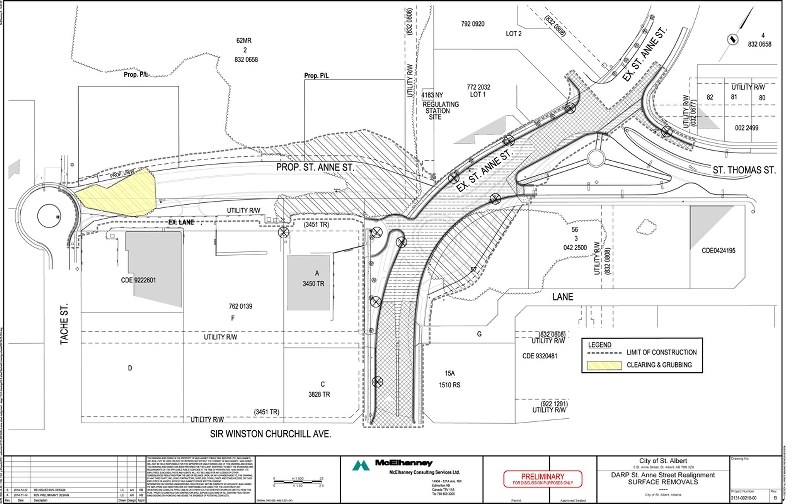City crews will chop down part of a century-old forest near the Grandin Medical Clinic in the next two weeks to make way for the new St. Anne Street.
The City of St. Albert gave notice this week that it would cut down more than 100 trees from the stands near Millennium Park and the St. Albert Economic Development building between March 30 and April 12 as part of its plans to realign St. Anne St.
The $4.18-million project will see St. Anne St. run along the north side of Cornerstone Hall and the Grandin Medical Clinic and add a roundabout to the street in front of the clinic.
To do that, crews will have to take out the tree stand just north of the hall, remove a U-shaped chunk from the stand north of the clinic, and axe about half of the stand behind the economic development building, said Sue Howard, capital projects manager for the City of St. Albert.
“The areas marked in yellow, all the trees in those areas will be removed,” she said, referring to a map released by the city.
Howard said the removal would affect about 142 trees, including trembling aspens, balsam poplars, Manitoba maples, saskatoons, diamond willows, and white spruce – the latter of which is the official coniferous tree of St. Albert.
The ground is still frozen, so crews won’t be able to excavate and replant any of the trees in these areas, Howard said. The city plans to announce any future large removals of trees a year in advance to give people time to salvage plants, she added.
“We’re trying to repurpose as many of the trees as we can,” she added.
Any white spruce from these stands will be used as obstacles in the proposed Riel bike skills park, for example, while aspen will be given to garden clubs to grow mushrooms. Everything else will be mulched for trails and flowerbeds.
Retired St. Albert forestry professor Peter Murphy, who took core samples from two trees in this area Thursday, pegged the age of the tree stands at somewhere between 90 and 110 years – older than he expected.
Based on aerial photos from the 1920s, Murphy said it’s reasonable to say that these trees are descendents of the tree stand from which Father Albert Lacombe cut logs for his first chapel in 1861.
“If you did a genetic analysis, I think you’d find that the trees are quite similar to what you’d find out in the (Grey Nuns White) Spruce Forest,” he said.
Crews will set out flags and signs on Monday to show which trees will be removed, with the actual removal to start later next week, Howard said. Crews will then dig down about a foot throughout the affected areas to remove any roots. All work will have to wrap up before April 15 to avoid affecting nesting birds.
Crews will plant about 30 boulevard trees, 27 ornamental trees and about 1,400 shrubs along the new St. Anne St. once it’s built, Howard said.
Actual construction of the street won’t start until after the International Children’s Festival in late May.
Removing these trees will put the rest of the tree stand at greater risk of blow-down, but could also make room for younger saplings, Murphy said.
“If those trees have to come out, we should try to save as much of the rest as we can.”
Questions on the project should go to Howard at 780-459-1737.




